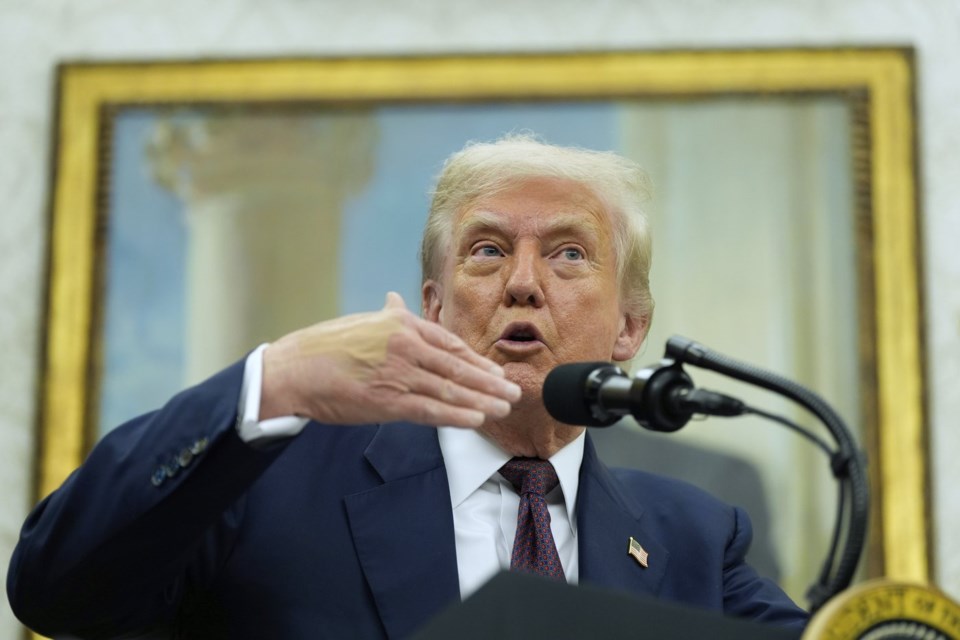WASHINGTON (AP) — President Donald Trump plans to sign an executive order requiring colleges to submit data to prove they do not consider race in admissions, according to a fact sheet shared by the White House ahead of the Thursday signing.
In 2023, the Supreme Court ruled against the use of affirmative action in admissions but said colleges may still consider how race has shaped students’ lives if applicants share that information in their admissions essays.
Trump's Republican administration is accusing colleges of using personal statements and other proxies to consider race.
The executive order is similar to parts of recent settlement agreements the administration negotiated with Brown University and Columbia University, restoring their federal research funding. The universities agreed to give the government data on the race, grade point average and standardized test scores of applicants, admitted students and enrolled students. The schools also agreed to an audit by the government and to release admissions statistics to the public.
Conservatives have argued that despite the Supreme Court ruling, colleges have continued to consider race through proxy measures.
The planned executive order makes the same argument. “The lack of available admissions data from universities — paired with the rampant use of ‘diversity statements’ and other overt and hidden racial proxies — continues to raise concerns about whether race is actually used in admissions decisions in practice,” the fact sheet said.
The first year of admissions data after the Supreme Court ruling showed no clear pattern in how colleges' diversity changed. Results varied dramatically from one campus to the next.
Some schools, such as the Massachusetts Institute of Technology and Amherst College, saw steep drops in the percentage of Black students in their incoming classes. But at other elite, selective schools such as Yale, Princeton and the University of Virginia, the changes were less than a percentage point year to year.
Some colleges have added more essays or personal statements to their admissions process to get a better picture of an applicant's background, a strategy the Supreme Court invited in its ruling.
“Nothing prohibits universities from considering an applicant’s discussion of how race affected the applicant’s life, so long as that discussion is concretely tied to a quality of character or unique ability that the particular applicant can contribute to the university,” Chief Justice John Roberts wrote in 2023 for the court’s conservative majority.
As an alternative to affirmative action, colleges for years have tried a range of strategies to achieve the diversity they say is essential to their campuses.
Many have given greater preference to low-income families. Others started admitting top students from every community in their state.
Prior to the ruling, nine states had banned affirmative action, starting with California in 1996. The University of California saw enrollment change after the statewide ban in 1996. Within two years, Black and Hispanic enrollments fell by half at the system’s two most selective campuses — Berkeley and UCLA. The system would go on to spend more than $500 million on programs aimed at low-income and first-generation college students.
The 10-campus University of California system also started a program that promises admission to the top 9% of students in each high school across the state, an attempt to reach strong students from all backgrounds. A similar promise in Texas has been credited for expanding racial diversity, and opponents of affirmative action cite it as a successful model.
In California, the promise drew students from a wider geographic area but did little to expand racial diversity, the system said in a brief to the Supreme Court. It had almost no impact at Berkeley and UCLA, where students compete against tens of thousands of other applicants.
Today at UCLA and Berkeley, Hispanic students make up 20% of undergraduates, higher than in 1996 but lower than their 53% share among California’s high school graduates. Black students, meanwhile, have a smaller presence than they did in 1996, accounting for 4% of undergraduates at Berkeley.
After Michigan voters rejected affirmative action in 2006, the University of Michigan shifted attention to low-income students.
The school sent graduates to work as counselors in low-income high schools and started offering college prep in Detroit and Grand Rapids. It offered full scholarships for low-income Michigan residents and, more recently, started accepting fewer early admission applications, which are more likely to come from white students.
Despite the University of Michigan's efforts, the share of Black and Hispanic undergraduates hasn’t fully rebounded from a falloff after 2006. And while Hispanic enrollments have been increasing, Black enrollments continued to slide, going from 8% of undergraduates in 2006 to 4% in 2025.
___
Associated Press Education Writer Jocelyn Gecker contributed to this report.
___
The Associated Press’ education coverage receives financial support from multiple private foundations. The AP is solely responsible for all content. Find the AP’s standards for working with philanthropies, a list of supporters and funded coverage areas at AP.org.
Annie Ma, The Associated Press




